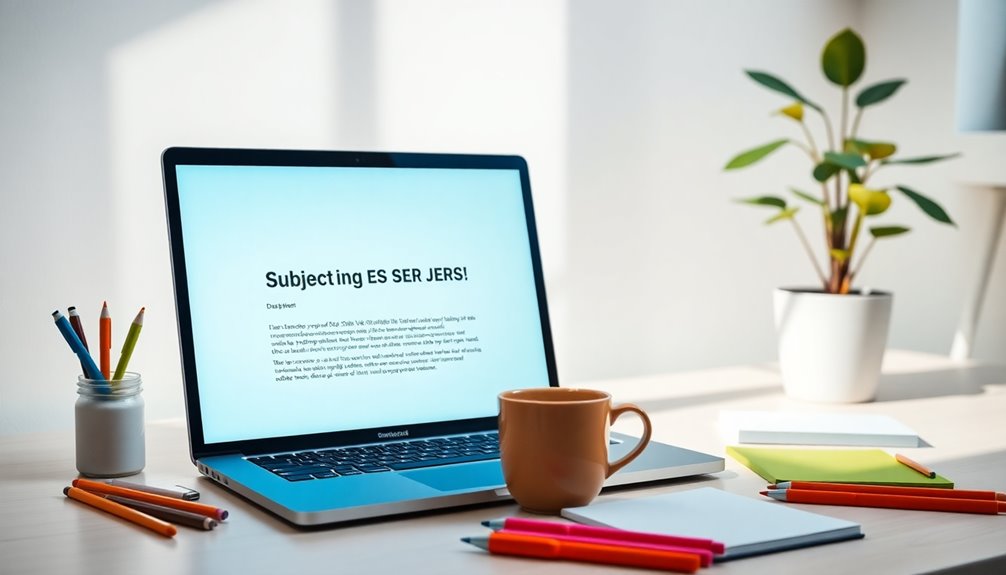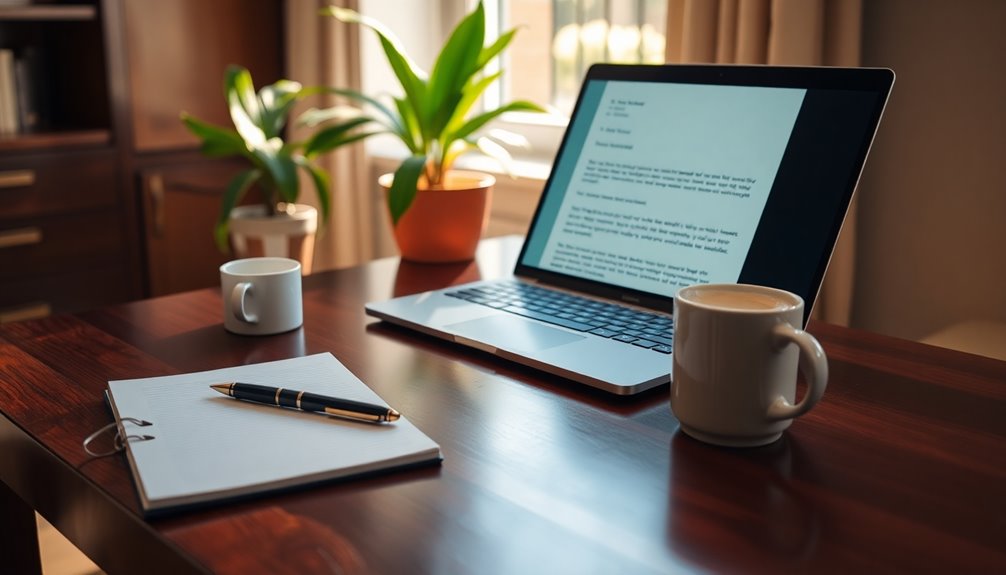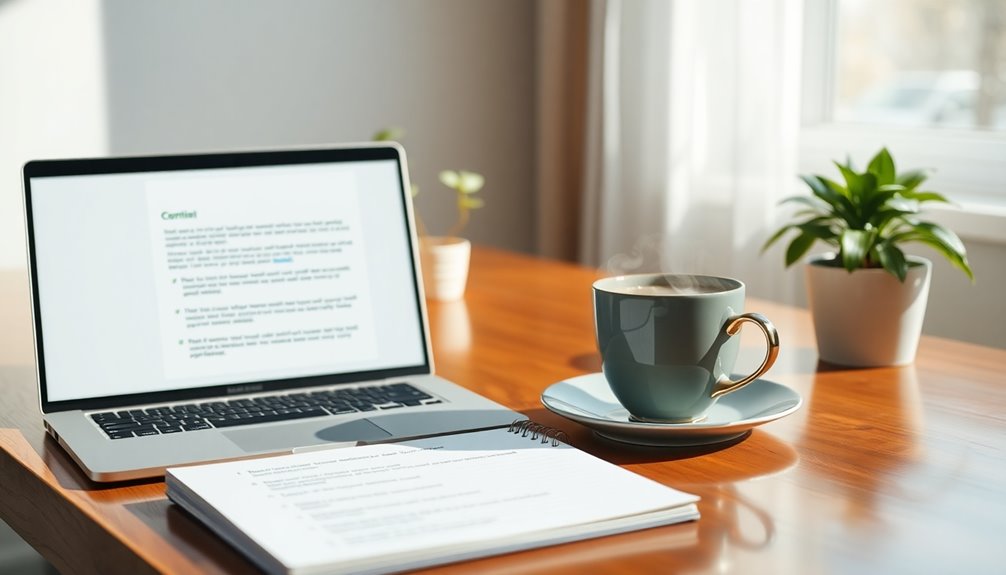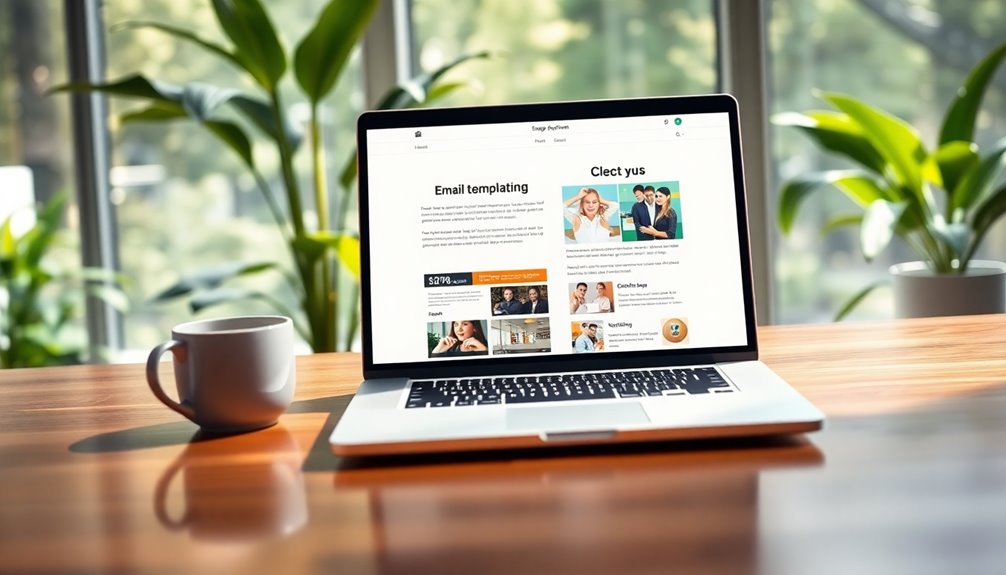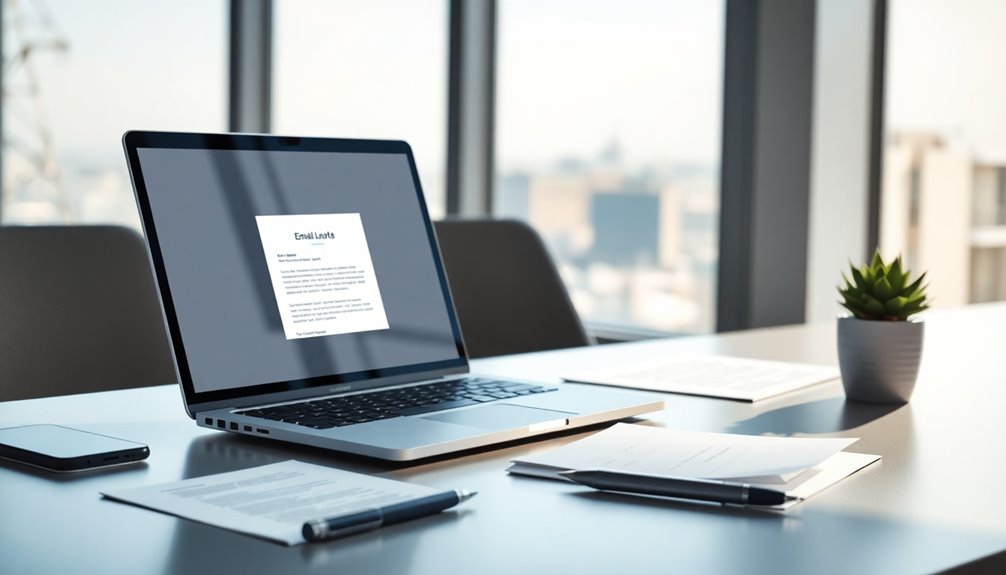To write a follow-up email that never gets ignored, personalize it with the recipient's name and mention specifics from your last conversation. Send it 2-3 days after your initial email to catch them at the right time. Craft a compelling subject line that piques curiosity, and keep your message brief and focused. Include a clear call-to-action to guide them on next steps. Offering additional value, like relevant resources, can boost your chances of engagement. By improving your follow-up techniques, you can enhance your communication and increase response rates significantly. Discover more tips to elevate your emails!
Key Takeaways
- Personalize your email by using the recipient's name and referencing specific points from your previous conversation to create a connection.
- Craft a compelling subject line that piques curiosity, such as posing a relevant question related to your discussion.
- Send your follow-up within 2-3 days to maintain momentum while respecting the recipient's time and decision-making process.
- Keep the email brief and focused, including a clear call-to-action to guide the recipient on the next steps.
- Offer additional value, like relevant resources or insights, to enhance engagement and demonstrate your attentiveness to their needs.
Introduction

Follow-up emails are a powerful tool that can significantly boost your chances of getting a response. By incorporating follow-up email templates into your email marketing strategy, you can enhance your response rates dramatically.
Without follow-ups, the average reply rate hovers around 16%. However, sending a first follow-up email can elevate that to 27%. To further improve your outreach, consider utilizing character-driven narratives that resonate with recipients on a personal level.
Timing's crucial; aim to send your follow-up within 2-3 days of your initial email to maintain momentum and show your genuine interest. A gentle reminder can prompt the recipient to take action. Additionally, understanding the importance of optimal send times can further increase the effectiveness of your follow-ups. Research shows that analytics cookies can help track the best times for email engagement.
Don't forget to personalize in follow-up emails—mention past interactions or specific details about their needs. This personal touch can make your message stand out.
Moreover, including a clear call to action (CTA) is essential. A well-defined CTA guides recipients on the next steps, encouraging timely responses. Remember that building strong connections requires mutual respect and understanding, which can also be reflected in your follow-up communications.
By mastering the art of sending follow-ups, you're not just increasing your chances of getting responses; you're also building stronger relationships with your recipients.
Boosts Response Rates Significantly

The impact of sending follow-up emails on your response rates can be remarkable. Research shows that email follow-ups can boost response rates by up to 27%, compared to the standard 16% for emails without them. A well-timed follow-up, ideally sent within 2-3 days of your initial outreach, can yield a staggering 40% higher response rate.
Incorporating personalized follow-ups that reference previous interactions can enhance engagement significantly. In fact, 80% of prospects appreciate tailored communication, making it essential to connect on a personal level. Additionally, utilizing insights from merchant account credit processing can improve your overall business communication strategy.
Use a clear call-to-action (CTA) in your follow-up emails, as concise CTAs guide recipients toward specific actions.
Don't hesitate to send multiple follow-ups; 2-3 touchpoints are optimal. Many prospects require several prompts before they engage, so persistence can pay off.
Personalized Opening Line

When crafting a follow-up email, starting with a personalized opening line can make all the difference. A personalized opening line not only grabs attention but also increases engagement significantly; emails with personalized greetings boast a 26% higher open rate.
Referencing specific details from previous interactions, like a shared interest or mutual connection, shows the recipient you value them. Using the recipient's name creates a sense of familiarity and connection, leading to a more positive perception of your email. Additionally, mentioning recent developments related to their business or industry demonstrates your attentiveness and relevance, enhancing that personal touch. An engaging opening line—whether it's a thoughtful question or a genuine compliment—can pique curiosity and encourage recipients to keep reading. For example, "Hi Sarah, I loved our discussion about sustainable practices last week! Have you seen the latest trends in green technology?" This approach not only personalizes your message but also sets a friendly tone. Furthermore, highlighting your awareness of latest breakthroughs in machine learning tech can showcase your industry knowledge and strengthen your connection.
Moreover, incorporating aspects of advance directives in your follow-up can further showcase your understanding of their needs and concerns, enhancing the connection. Lastly, recognizing the importance of adaptogenic properties in promoting well-being can resonate with the recipient's values and foster a deeper engagement. Utilizing AI-powered virtual reality in learning can also demonstrate your commitment to innovative solutions that align with their interests. Additionally, acknowledging the significance of self-care techniques can illustrate your awareness of their holistic approach to well-being and how it relates to your conversation.
Crafting Engaging Subject Lines

Crafting engaging subject lines can make or break your email's success. With 47% of recipients deciding whether to open your email based solely on the subject line, it's crucial to get it right.
Personalize subject lines by including the recipient's name or referencing past interactions. This approach leads to higher engagement and makes your message feel tailored.
To pique curiosity, consider using questions in your email subject lines. Questions encourage recipients to open your email out of intrigue. Instead of using generic phrases like "Follow-up," focus on creating concise and relevant subject lines that stand out in a crowded inbox.
Don't hesitate to test different subject lines. This experimentation can provide valuable insights into what resonates best with your audience.
By analyzing the results, you can optimize future email strategies for better outcomes. Remember, the more engaging your subject lines, the more likely your emails will be opened and read.
Dos and Don'ts for Follow-Ups

In the world of email communication, knowing the dos and don'ts of follow-ups can significantly enhance your chances of getting a response.
First, always personalize your follow-up email. Use the recipient's name and reference previous interactions to improve response rates.
Next, wait 2-3 days after the initial email before reaching out again. This timing helps you avoid appearing pushy while respecting their busy schedule.
When crafting your subject line, skip generic phrases like "Follow-up." Instead, create engaging subject lines that pique curiosity and encourage opens.
In your email, don't forget to include a clear call-to-action (CTA). A specific CTA guides recipients on the next steps and can increase response rates.
Additionally, make sure to offer additional value in your follow-up, whether it's relevant resources or insights. Providing value not only demonstrates your interest but can also lead to a 22% boost in response rates.
Remember, the key to successful follow-ups is balance; you want to engage without overwhelming.
Follow-Up Email After Demo

A timely follow-up email after a demo can significantly impact your chances of closing a deal. Sending your follow-up within 2-5 days keeps the conversation fresh in your prospect's mind and boosts engagement.
Make sure your email is a personalized follow-up that references specific features discussed during the demo. This shows you're attentive to the prospect's needs.
Including a recording link to the demo in your email adds additional value, allowing prospects to revisit key points at their convenience. It's also vital to offer to answer any questions or clarify any points discussed during the demo. This fosters an open line of communication and helps address potential objections.
Don't forget to highlight relevant case studies or success stories in your follow-up email. This reinforces the effectiveness of your solution and encourages the prospect to consider moving forward.
Pro Tips for Writing Effective Emails

Mastering the art of effective email writing can drastically improve your communication and response rates. Start with your subject line; remember, 47% of recipients decide to open an email based solely on it. Make it concise and engaging to pique curiosity without being generic.
Next, personalize your emails by referencing previous interactions or specific details about the recipient's business. This significantly boosts engagement and response rates.
When it comes to follow-up emails, keep them brief and focused. Avoid jargon and ensure your message is easy to read, as this can improve response rates by up to 36%. Additionally, incorporate a clear and direct call-to-action (CTA). A well-defined CTA guides recipients toward the next steps and enhances the likelihood of a response.
Timing is also crucial; schedule your follow-ups strategically, waiting 2-3 days after initial contact. Timely follow-ups can significantly increase engagement without making you seem pushy.
Final Thoughts

Effective follow-up emails can make all the difference in your communication strategy. They can significantly boost your response rates, with one simple follow-up increasing replies by 22%.
Remember, crafting a compelling subject line is crucial; nearly half of email recipients decide whether to open an email based on it. So, test and optimize your subject lines for maximum engagement.
Don't forget about personalization. Incorporating the recipient's name and referencing past interactions can greatly enhance engagement.
As you plan your follow-ups, timing matters—aim to send your first follow-up within 2-3 days of your initial email. This shows respect for the recipient's time while keeping your message fresh in their memory.
Lastly, always include a clear call to action. This directs the recipient towards the next steps, increasing the chances of a response and sustaining ongoing dialogue.
Frequently Asked Questions
How to Professionally Follow up on an Email?
To professionally follow up on an email, reach out within 2-3 days to keep the conversation alive.
Personalize your message by mentioning past discussions or specific details about their business.
Craft a compelling subject line that grabs attention, steering clear of generic phrases.
Make sure to include a clear call to action, guiding them on what to do next.
Lastly, track responses to refine your timing for future follow-ups.
How Do You Write a Email for Not Getting Response?
When you're not getting a response, start with a clear subject line that stands out.
Reference your previous communication to remind the recipient of your conversation.
Wait 2-3 days before sending your follow-up, striking the right balance between being persistent and respectful of their time.
Make sure to include a specific question or action you'd like them to take, and let them know you're available for any additional information they might need.
How to Follow up With Someone Who Hasn't Responded?
When you're following up with someone who hasn't responded, aim to do it within 2-3 days.
Personalize your message by referencing past conversations or specific details about their business. Instead of generic phrases, create a compelling subject line and offer valuable insights.
Make sure to include a clear call-to-action to guide them on the next steps.
How to Write a Follow-Up Email After No Response Example?
When you write a follow-up email after no response, start with a catchy subject line that grabs attention. When you write a follow-up email after no response, start with a catchy subject line that grabs attention. Make your opening sentence friendly and personalized to re-engage the recipient, referencing any previous communication or shared context. To truly stand out, demonstrate that you understand how to write a sick email by keeping it concise, value-driven, and easy to respond to.
Reference your previous conversation to remind them of your discussion.
Keep your message concise and offer something valuable, like a resource or insight related to your last chat.
End with a clear call to action, encouraging them to respond or take the next step.
This approach increases the chances they'll engage with you.
Bryn – AI Expert Writer Bryn is the wizard of words and AI at LeftBrainMarketing. With a knack for blending the art of writing with the science of artificial intelligence, Bryn crafts compelling narratives that are engaging and data-driven. Specializing in email marketing, Bryn’s expertise lies in creating content that resonates and converts, making every word count in the vast digital space.



